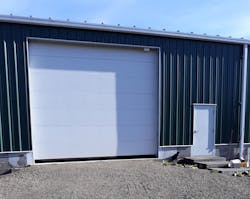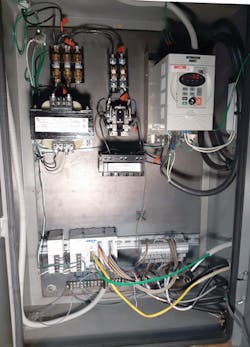After a career in electronics, instrumentation and automation—combined with a lifelong affinity for all things mechanical—I can’t help but keep an eye out for any equipment or system I can improve, no matter how small. Recently, I completed a project to re-automate a commercial-grade garage door opener using an industrial-grade programmable logic controller (PLC), a human-machine interface (HMI) and a variable speed drive (VFD). The result met my specific needs and is far better than the stock equipment, and it is an example of how users can execute many types of similar projects at home or work.
When Stock Isn’t Good Enough
Although I’m now retired, I’m fortunate to have a 60 × 100 ft garage building on my property where I can keep various “toys,” such as recreational vehicles, a tractor and even a dump truck. Access into the garage is via a 16-ft-wide by 14-ft-high rollup door, operated by a commercial-grade electric door opener.
This popular brand of door opener is much like what would be found on any typical residential garage door, but with a beefed-up motor and a chain drive reduction system. The stock drive uses a 120 V AC 0.5 hp motor, with sprockets and chains to reduce the nominal 1,800 RPM motor speed to something far less for driving the door at an appropriate speed, and with torque multiplication.
The basic mechanical door operation was adequate, but the opener used what I call “bang-bang” control. Each time the user pushed the wall button or remote control, the opener either banged all the way open at full speed or it banged all the way closed at full speed. Other than the jarring sound this made and some level of mechanical impact on the door, the real problem was that the various drive chains would be slammed so hard that they would stretch. And once the chains stretched, the jarring action became worse, and the resulting sloppiness in the mechanism could lead to the door being over- or under-operated.
When new, the various chains were properly tensioned on their respective sprockets. However, no provisions were made to compensate for the type of chain stretch normal for roller chains as they age. The controls simply turned the motor on at maximum rpm, exacerbating chain stretch as the motor attempted to accelerate the rather massive door from standstill to maximum speed instantly. After a few thousand cycles, the starting of door movement became noticeably violent because of the excessive “slop” in the speed reduction mechanism. The opener was doomed to mechanical failure if corrective action wasn’t taken.
If anything went wrong with the opener, there was little in the way of diagnostic information for troubleshooting. For instance, one time the motor was operating erratically, and after considerable troubleshooting, it was finally determined that a spider had built a web in front of an optical sensor, which triggered false operation.
In addition to wanting to overcome these drive problems, I also had some particular needs for my purposes. Sometimes I only wanted to open the door enough for a small car to enter. Other times I needed the door to accommodate a much higher dump truck, or to open fully to its 14-ft height. These multiple positions save wear-and-tear on the door mechanism, but the real motive is to retain as much heat in the winter and cool air in the summer inside the building by opening the door only as much as necessary. Other times I would like the door to be opened just about 6 in. off the ground so my barn cats could get in and out, while still maintaining a degree of access security.
Based on these needs, I decided to use my industrial automation experience and some readily available off-the-shelf devices to upgrade the door so it would work the way I wanted, and to add features.
Upgraded Solution
Having worked with various makes and models of PLCs, HMIs, VFDs and other automation components, I already was familiar with many of the options available from AutomationDirect. I surveyed what was needed for the project, keeping in mind this was on a personal budget, and selected the following devices, which were easily installed into a control panel:
- CLICK Series stackable micro-brick PLC: plenty of logic capability, lots of I/O options, communication ports and free programming software.
- C-more Micro touch panel: 6-in. color touchscreen, with five user-definable buttons and free programming software.
- GS2 Series AC Drive: able to accept 120/240 V 1P/3P input power and generate 240 V 3P output with communications.
- IronHorse 0.5HP 3P motor: inverter rated, and suitable for pre-mounting on the door opener.
- Various sensors, wiring accessories such as ZIPLink pre-wired connection cables and other items.
Because the cutover from old to new controls needed to be performed quickly—so the door would remain usable—it was essential to pre-test the system as much as possible. A carefully detailed control system architecture drawing was created to show the connections, pinouts and settings of each device.
The project took advantage of serial communications between the PLC and the VFD, providing the PLC with the maximum data and control functionality possible from the motor controls. The appropriate cable was selected, but during initial testing, some lags in operation and communication errors were noticed. This was eventually solved by shielding the cable better, which is good practice any time communication cables are run near 3-phase power or inverter outputs. Another factor is that the panel is energized by a rural power grid, which can experience momentary dropouts and brownouts.
Programming New Functionality
There are traditional limit switches on the door to indicate various travel positions. For the upgrade, a proximity switch and a sprocket were added to act as a simple encoder and provide pulse counts to the PLC, so the door travel distance could be tracked with an effective position repeatability of better than ±0.25 in. The pulse count is zeroed every time the door closes fully.
Control buttons and a touchscreen display are available to the user. With all these elements, it was possible to create much more advanced functionality including:
- Automatic, manual, and jog up/down capabilities.
- Normal close function.
- Open to pre-determined heights of approximately 6 in. (for ventilation), 8 ft (for people and standard vehicle access) and fully open (for large equipment access).
- Jog up or down function.
- Accelerate from start, and decelerate to finish, for each motion to minimize mechanical wear. This also helps ensure that the door more precisely reaches the target position because it is moving slower. This single feature alone extended the mechanical lifespan of the door drive mechanism dramatically to the extent it may never need repair, but instead just routine maintenance.
- Provisions for the system to determine where the door is located upon a reboot after a power failure.
- Extensive diagnostics via the HMI that, such that in most cases, need no other troubleshooting tools are needed.
Both the PLC and the HMI development software were easy to use with a straightforward feature set, and AutomationDirect provided helpful support via the phone and internet to resolve a few minor hardware and software issues. For the PLC programming, a single level of nested subroutines was used to make the program organized and modular.
There are a few more advanced features which would have been helpful if more advanced functionality was needed in the PLC software, such as nesting more levels of subroutines, searching for subroutine calls by name and applying visibility animation to grouped objects instead of just individual objects on the HMI. But overall, the free software is extremely capable and easy for anyone to learn and work with.
Making Things Your Way
Consumer goods are often quite advanced today as manufacturers strive to meet consumer needs. But there are still cases, such as the standard garage door opener, where the results fall short. For this situation, I was able to use components to create a control system that operated the equipment more efficiently and economically with less wear, while adding many functional and diagnostic capabilities.
Using devices such as these with support for standard communication protocols makes it easy to add future functionality. The system currently uses a traditional garage door opener remote control button, but I could easily add internet accessible capability for monitoring and control. As with any new design there have been some glitches, mostly in programming, but with all the system data made visible via the HMI, troubleshooting has been relatively effortless. Careful design and documentation will make it easy for anyone to work on the system.
This project serves as a good example of how end-users can approach an automation project, whether at home or at work, and make it their own.
Mike Thiel is a retired engineer whose career began as U.S. Navy specialist working on gun fire-control computers, radar and electronic counter-countermeasures. He later had roles as an electronics technician and an electrical engineer working with material handling, robotics, and combustion hardware and software design. Electronics has always been a hobby for him, and he is always on the lookout for interesting projects to work on. Thiel also operates a garlic farming operation and can be reached for farming or technical inquiries at [email protected].



